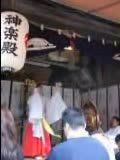 | ||
Shinto music is the ceremonial and festive music of Shinto (神道), the native religion of Japan. Its origin myth is the erotic dance of Ame-no-Uzume-no-Mikoto which lured Amaterasu from her cave.
Contents
Kagura
Kagura (神楽) or 'entertainment of the gods' includes music, dance and poetry and comprises mi-kagura of the court, o-kagura of major shrines such as Ise Jingū, and village sato-kagura.
Forms
The repertoire includes eight forms that may be traced back to the eighth century: kagura-uta (kagura songs), azuma asobi (eastern entertainment), kume-uta (palace guard songs) ō-uta (big songs), onaibi-uta (night duty songs), ruika (funeral songs), ta-uta (field songs), and yamato-uta (Yamato songs).
Instruments
Instruments include the wagon (和琴), kagura-bue (神楽笛), hichiriki (篳篥), suzu (鈴), tsuzumi (鼓), and shakubyōshi (笏拍子) clappers. In local festivals the kane (鉦), binzasara (編木), and taiko (太鼓) may also be found.
